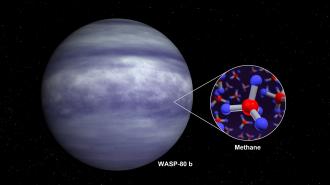Using data from the James Webb Space Telescope (JWST), astronomers have identified the presence of methane — a molecule linked to the presence of life — in the atmosphere of a “warm Jupiter” exoplanet.
While this particular exoplanet is likely too hot to be inhabited itself, the discovery shows that the JWST will be a powerful tool in the hunt for alien life.
The challenge: Methane is a carbon-bearing molecule, and on Earth, it is almost always produced by living things. That means seeing an abundance of methane in the atmosphere of an exoplanet could indicate that it hosts life.
In 2008, Hubble detected methane in the atmosphere of an exoplanet for the first time, but since then, such sightings have been rare.
An abundance of methane in the atmosphere of an exoplanet could indicate that it hosts life.
What’s new? The pace of these discoveries appears to be picking up, thanks to the JWST.
In September, a University of Cambridge-led team reported that it had used the telescope to detect methane around an exoplanet for the first time, and now, a group led by scientists at Arizona State University (ASU) has used it to detect methane around a different exoplanet.
“Before JWST, methane had remained largely undetected, despite expectations that it could have been detected with Hubble Space Telescope in planets where it should have been abundant,” said researcher Michael Line, an extrasolar planetologist at ASU.
The study: The exoplanet at the core of the study, WASP-80 b, is a gas giant located about 163 light years away from Earth. Because it has a similar size and mass to Jupiter but a higher surface temperature, it’s considered a “warm Jupiter” (“hot Jupiters” are Jupiter-like planets with extreme temperatures).
To determine the composition of WASP-80 b’s atmosphere, the ASU team studied how the light from its host star dimmed as the exoplanet passed in front of it from our perspective, a technique known as the “transit method.”
“It’s kind of like when someone passes in front of a lamp and the light dims,” said researcher Luis Welbanks. “During this time, a thin ring of the planet’s atmosphere around the planet’s day/night boundary is lit up by the star.”
“At certain colors of light where the molecules in the planet’s atmosphere absorb light, the atmosphere looks thicker and blocks more starlight, causing a deeper dimming compared (with) other wavelengths where the atmosphere appears transparent,” he continued.
“Before JWST, methane had remained largely undetected.”
Michael Line
The team also studied the light from the system as the warm Jupiter passed behind its star — that technique is known as the “eclipse method.”
“All objects emit some light, called thermal radiation, with the intensity and color of the emitted light depending on how hot the object is,” said Wellbanks and Taylor Bell, a researcher from the Bay Area Environmental Research Institute.
“For eclipse spectra, absorption by molecules in the planet’s atmosphere typically appear as a reduction in the planet’s emitted light at specific wavelengths,” they added.
The big picture: While WASP-80 b does appear to have methane in its atmosphere, it also has a blistering average temperature of 1,025 F. That makes the warm Jupiter highly unlikely to host life as we know it. Even tardigrades — one of the hardiest known species — can’t survive temps above 300 F.
Still, because methane is so rarely spotted in the atmospheres of exoplanets, its detection anywhere is a boost for astronomy, and the study could help inform future research focused on planets that are better equipped to host life.
“As we find methane and other gasses in exoplanets, we will continue to expand our knowledge about how chemistry and physics works under conditions unlike what we have on Earth, and maybe sometime soon, in other planets that remind us of what we have here at home,” said Wellbanks and Bell.
We’d love to hear from you! If you have a comment about this article or if you have a tip for a future Freethink story, please email us at [email protected].




